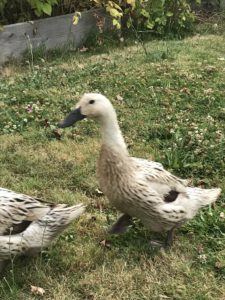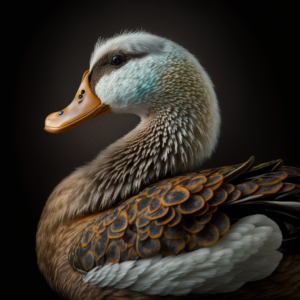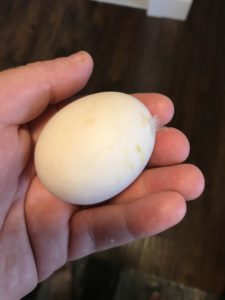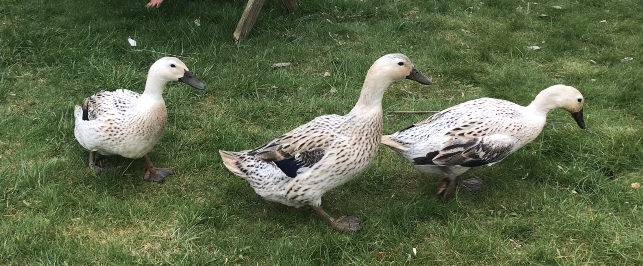Duck Layer Feed Improves Egg Production
Switch from grower to a quality duck layer feed to encourage healthy egg production at the 20-week mark in their growth. Layer feed should be 16% protein and have a higher amount of calcium and essential vitamins for duck health.
What is Layer Feed
Layer feed for chickens and ducks is specifically designed for egg-laying birds. Around the 20-week mark until the end of their life egg laying ducks should be receiving layer feed for the majority of their daily diet. Stage one is feed for ducklings, commonly referred to as starter or starter crumble. Grower feed is stage two for ducks between 3 weeks and 20 weeks of age. As a result layer feed is referred to as stage three feed. It will include a higher level of calcium which is essential in producing eggs with strong eggshells.
Organic Duck Layer Food
Organic feed options for ducks and chickens include both pellet and cracked grain and meals. You will always pay more for organic duck layer feed than traditional feed. However, the benefits may be more important to you and your family to know you are giving your birds organic grains only. I am a big fan of the naturally free organic layer feed 16% protein for chickens and ducks made by Scratch and Peck feeds. It includes select vitamins and the grains and flax meals are sourced from North American Farms.
Pellet feed is always cheaper per pound than cracked whole grain with flax meals. We offer our birds a mix of feed at times. Plus, plenty of foraging opportunities to get bigs, worms, and tasty greens in our backyard orchard.
Fermenting whole grains by soaking them in water overnight is another way to enhance the nutritional value of your poultry feed and stretch the amount that is given each day. Soak the whole grain feed overnight or even 2 days during the cooler months of the year to receive the additional benefits. Do not soak pellets or crumble feed as they will turn to mush. The ducks will still eat the mush. However, if you have a mixed flock of chickens & ducks, the chickens will be less than thrilled.

Non-Organic Options for Ducks
Nonorganic layer feed for backyard poultry flocks is more economical than organic options. We have given our birds both nonorganic and organic feeds. The birds do well and produce high-quality eggs on both. A nonorganic option is easy to source. While sourcing from a local farm store is always a great option to support small businesses that will go the extra mile to help you. It is possible to find non-organic poultry feed at big box stores such as Walmart at very affordable prices.
Difference between Layer and Grower
Layer feed is around 16% protein. This is the right amount of protein for bird maintenance. Duck layer feed is higher in calcium than both starter and grower feed. Ultimately, mature ducks laying eggs require a large amount of calcium to maintain healthy production levels.
Urban homesteaders often supplement the calcium for their flock with a calcium supplement, oyster grit, or by offering sanitized crushed eggshells after eating the eggs. However, the best plan is to offer the egg layers in your flock a stage three feed for the majority of their diet. Many duck owners give their snacks for ducks that are not healthy, avoid doing this and give them a quality feed to be happy and healthy.
Ducks that get a lot of nutrition from foraging in your yard and farm still benefit from the additional calcium, vitamins, and protein from a proper whole cracked grain or pellet food. Give your birds what they need and offer feed in the morning and night.

Can Male Ducks Eat Layer Feed
Yes, you can feed your male drakes the same layer pellets / feed as you are giving the girls. The male birds will be just fine eating this feed.
When to Give Layer Feed to Ducks
As soon as your ducks begin egg production it is important to switch from a grower to a layer feed. The additional calcium mixed into layer pellets or feed is essential for the development of the egg shells.

What Should You Look for in a Quality Duck Food?
The most important thing to look for in a good layer feed for egg production is a complete feed for their nutritional needs. Mature ducks need to consume feed that is at or slightly above 16% protein. Layer feed should also include calcium and vitamins that are critical to egg production.
How Long Does Layer Feed Last?
Read the details on the packaging for poultry feed that you have purchased concerning the shelf life. However, a good rule of thumb to consider is if the feed is properly stored in a moderate temperature, dry environment it can store for up to 4 months. It is always recommended to use feed up in 60 days when in a hot and humid region and within 90 days when in a cooler location.




Recent Comments